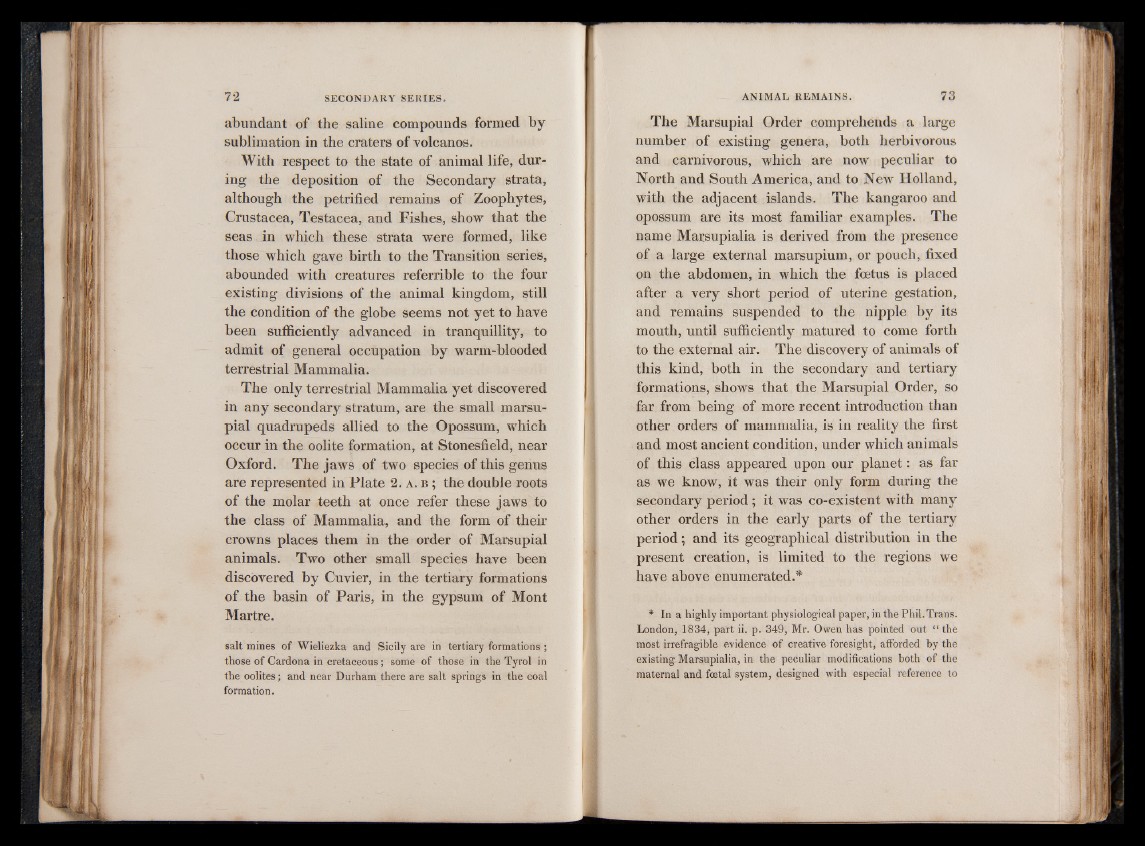
abundant of the saline compounds formed by
sublimation in the craters of volcanos.
With respect to the state of animal life, during
the deposition of the Secondary strata,
although the petrified remains of Zoophytes,
Crustacea, Testacea, and Fishes, show that the
seas in which these strata were formed, like
those which gave birth to the Transition series,
abounded with creatures referrible to the four
existing divisions of the animal kingdom, still
the condition of the globe seems not yet to have
been sufficiently advanced in tranquillity, to
admit of general occupation by warm-blooded
terrestrial Mammalia.
The only terrestrial Mammalia yet discovered
in any secondary stratum, are the small marsupial
quadrupeds allied to the Opossum, which
occur in the oolite formation, at Stonesfield, near
Oxford. The jaws of two species of this genus
are represented in Plate *2. a. b ; the double roots
of the molar teeth at once refer these jaws to
the class of Mammalia, and the form of their
crowns places them in the order of Marsupial
animals. Two other small species have been
discovered by Cuvier, in the tertiary formations
of the basin of Paris, in the gypsum of Mont
Martre.
salt mines of Wieliezka and Sicily are in tertiary formations ;
those of Cardona in cretaceous; some of those in the Tyrol in
the oolites; and near Durham there are salt springs in the coal
formation.
The Marsupial Order comprehends a large
number of existing genera, both herbivorous
and carnivorous, which are now peculiar to
North and South America, and to New Holland,
with the adjacent islands. The kangaroo and
opossum are its most familiar examples. The
name Marsupialia is derived from the presence
of a large external marsupium, or pouch, fixed
on the abdomen, in which the foetus is placed
after a very short period of uterine gestation,
and remains suspended to the nipple by its
mouth, until sufficiently matured to come forth
to the external air. The discovery of animals of
this kind, both in the secondary and tertiary
formations, shows that the Marsupial Order, so
far from being of more recent introduction than
other orders of mammalia, is in reality the first
and most ancient condition, under which animals
of this class appeared upon our planet: as far
as we know, it was their only form during the
secondary period; it was co-existent with many
other orders in the early parts of the tertiary
period; and its geographical distribution in the
present creation, is limited to the regions we
have above enumerated.*
* In a highly important physiological paper, in the Phil. Trans.
London, 1834, part ii. p. 349, Mr. Owen has pointed out “ the
most irrefragible evidence of creative foresight, afforded by the
existing Marsupialia, in the peculiar modifications both of the
maternal and foetal system, designed with especial reference to